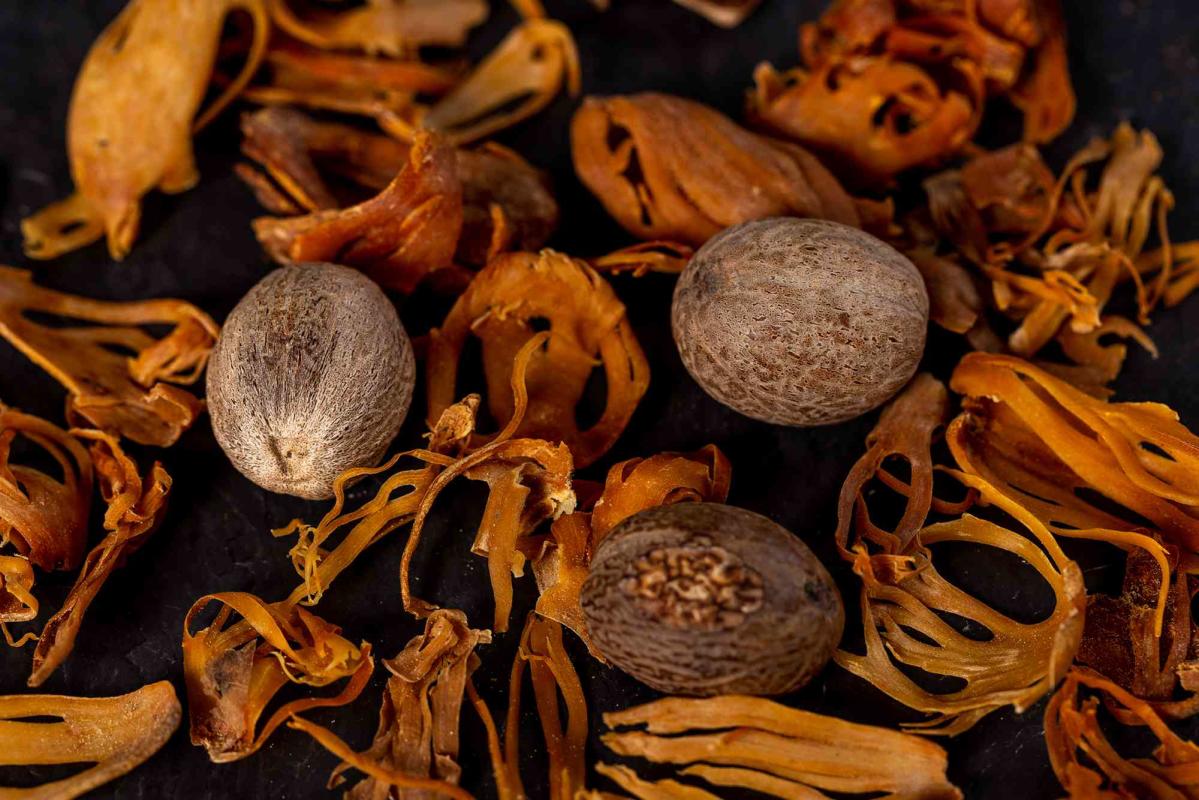There’s a lot more to this spice than the pinch used in pumpkin pie or eggnog.
Nutmeg is a spice derived from the genus Myristica plant native to both Africa and Eastern Indonesia. Myristica fragrans (fragrant nutmeg) comes from the Indonesian Banda Islands, also known as the Spice Islands, and is among the earliest spices traded in history. As the early spice trade developed along what we now call the Silk Road, nutmeg traveled from those small Indonesian Islands to become a beloved spice heavily used by cultures around the world.
According to The Nutmeg Trail by Eleanor Ford, “We can deduce that deliberate spice trade started around 2000 BC. From Austronesia to India traveled crops, including… spices like nutmeg, mace, and cloves. In return, India and Sri Lanka sent peppercorns [and] cinnamon.”
Monodora myristica is a nutmeg plant native to Africa that is called Calabash Nutmeg or Ehuru and is broadly used in African and West Indian cuisine.
What Is Nutmeg?
Nutmeg is not a nut but a seed of the Myristica plant. The fragrant nutmeg plant produces a golden-hued apricot-like fruit. The kernel of that fruit is where nutmeg and mace, the outer skin of the nutmeg kernel called the aril, are sourced. When the nutmeg kernel and arils are fresh, they have a glossy appearance from the oils in the nutmeg. Once they are dried into the spice, they lose their shiny exterior. It takes 6-8 weeks of drying in order to prepare the nutmeg seed to be used as a spice.
RELATED: These Single-Origin Spices Transformed My Pantry, and I’ll Never Cook with Anything Else
How Is Nutmeg Used?
In the United States, nutmeg is popularly used as a baking spice in cooler months. It’s used heavily in fall desserts, in pumpkin spice blends, and it’s what gives eggnog its distinct flavor. Nutmeg is more widely used in Black diaspora cooking because of its history in African and Caribbean cuisine.
Beyond the United States and its use in desserts, nutmeg is used in savory cooking as well. It is an essential part of spice blends like garam masala and quatre épices. Nutmeg is subtly layered into the mother sauce, bechamel, and can also be found in Jamaican jerk seasoning spice. On the island of Penang in Malaysia, the astringent fruit is sweetened and used in juice.
“Nutmeg goes beyond the holiday season for me,” says Samantha Fore, chef and owner of Tuk Tuk Sri Lankan Bites in Lexington, Kentucky. “I know it’s super common in pies and eggnog and whatnot, but I like to use its warmth in jaggery custards or even with savory dishes. I’ll use a touch for a butternut squash soup or a pumpkin curry, but I think a little used as a finisher — finely grated over heartier meat dishes and sauces — adds a whole new dimension. “
Nutmeg is not just used as a culinary spice. In Ayurvedic and Iranian medicinal practices, it is administered as an astringent, digestive aid, and to help with insomnia.
Monodora myristica is also known as Ehuru, Calabash, or African nutmeg and was once considered to be a substitute for Indonesian nutmeg. During the trade of enslaved people, this variation was introduced to the Caribbean and is sometimes known as Jamaican nutmeg. Instead of an apricot-shaped fruit, the Calabash plant is shaped like an upside-down orchid and because of its beauty is often used as an ornamental plant. Try this Ehuru and Wildflower Honey Butter recipe if you are seeking to try Calabash nutmeg at home.
Both variations of nutmeg are best used and most fragrant when freshly grated on a Microplane from the seed. Ground nutmeg can be used as well but it does not pack the flavor punch that freshly grated nutmeg does. Try grating it on top of whipped cream, brew it into your morning coffee, or add it to a batch of Rice Krispie treats. Or take a cue from Fore, “I sometimes combine it with cinnamon when just cinnamon is called for”.
RELATED: Patiently Wrought in Rum and Tradition, Black Cake Is a Triumph
What Is Mace?
Mace is the aril that webs around the Indonesian nutmeg seed. According to Ford, the leaves are “dried to auburn blades.” The flavor profile is more delicate and floral than the nutmeg. The dried leaves can be added to stews, curries, and soups. Ford recommends adding the dried arils “to cooking early and ground mace later to keep it sweet and fragrant.”
Looking to cook with nutmeg at home? Try these Indo-Caribbean Guyanese Gojas (Fried Coconut Turnovers) or these Banana Challah Fritters With Sweet Tahini Sauce, For savory options try this moussaka recipe or this Spiced Lentil Dip with Ginger and Coriander from Marcus Samuelsson.
